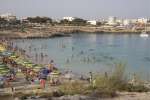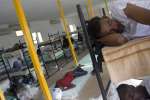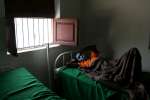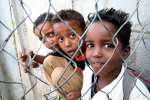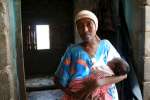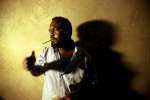Mixed Migration Expert Roundtables: 10-Point Plan Expert Roundtable No.1: Controlling Borders while Ensuring Protection (Geneva, Switzerland, 20-21 November 2008)
Migration, 21 November 2008
A first expert roundtable on UNHCR's 10-Point Plan of Action took place in Geneva on 20-21 November, 2008 with funding from the European Commission. Entitled "Controlling Borders while Ensuring Protection" and convened by UNHCR and the Graduate Institute of International and Development Studies, the roundtable was the first in a series of four thematic meetings on the refugee agency's plan to address refugee protection and mixed migration. Around 40 experts from governments, international governmental and non-governmental organizations, academia and UNHCR explored practical ways on how to operationalize refugee and human rights protection in the context of border and entry management. Emphasis was given to the challenges for the entry system related to the phenomenon of mixed migratory movements.
Below is a copy of the binder distributed at the roundtable as well as documents generated during and after the meeting. All documents are in English.
Roundtable Binder
1. MAIN ROUNDTABLE DOCUMENTS
- 1.1 Summary Report, December 2008
- 1.1 Annotated Agenda
- 1.2 Concept Note
- 1.3 Refugee Protection and Mixed Migration : A 10-Point Plan of Action
- 1.4 Participants List
2. REFUGEE PROTECTION AND INTERNATIONAL MIGRATION
- 2.1 10-Point Plan in Central America, Western Africa, Eastern Africa and Southern Asia – a two year Project (Information Note)
- 2.2 Regional Conference on Refugee Protection and International Migration in West Africa, Dakar, 13-14 November 2008, Draft Report of Working Group E, Enhancing Border Management while Ensuring Protection
- 2.3 Regional Conference on Refugee Protection and International Migration in the Gulf of Aden, Sana'a, Yemen, 19-20 May 2008, Summary Report, Chapter 3
- 2.4 Refugee protection and durable solutions in the context of international migration, Discussion Paper
- 2.5 UNHCR Web page – Mixed Migrations
3. SELECTED LEGAL AND POLICY RESOURCES AND POLICY
3.1 International Refugee Law and Policy
- 3.1.1 Convention Relating to the Status of Refugees, 28 July 1951, Selected Provisions
- 3.1.2 Convention Governing the Specific Aspects of Refugee Problems in Africa, 10 September 1969, Selected Provisions
- 3.1.3 Conclusion adopted by the Executive Committee on International Protection, Conclusion on Protection Safeguards in Interception Measures, No.97 (LIV)
- 3.1.4 Interception of Asylum-Seekers and Refugees: The International Framework and Recommendation for a Comprehensive Approach, 18th Meeting of the Standing Committee (EC/50/SC/CRP.17), 9 June, 2000
- 3.1.5 Global Consultations on International Protection, Summary Conclusions – The Principle of Non Refoulement, Cambridge 9-10 July 2001
- 3.1.6 Global Consultations on International Protection, Summary Conclusions on Article 31 of the 1951 Convention relating to the Status of Refugees, Geneva, 8-9 November 2001
- 3.1.7 Protection Refugees within broader migration movements, Agenda for Protection, Goal 2
3.2International Human Rights Law and Policy
- 3.2.1 Convention against Torture and Other Cruel, Inhuman or Degrading Treatment or Punishment, 10 December 1984, Selected Provisions
- 3.2.2 International Covenant on Civil and Political Rights, 16 December 1966, Selected Provisions
- 3.2.3 International Covenant on Economic, Social and Cultural Rights, 16 December1966, Selected Provisions
- 3.2.4 Human Rights Committee, General Comment 31, Nature of the General Legal Obligation on States Parties to the Covenant, Selected Paragraphes, No. 10 and 12, 29 March 2004
- 3.2.5 International Convention on the Protection of the Rights of All Migrant Workers and Members of Their Families, 18 December 1990, Selected Provisions
- 3.2.6 Recommended Principles and Guidelines on Human Rights and Human Trafficking, Selected Guidelines, 2002
3.3 International Criminal Law
- 3.3.1 Protocol to Prevent, Suppress and Punish Trafficking in Persons Especially Women and Children, supplementing the United Nations Convention against Transnational Organized Crime, 15 November 2000
- 3.3.2 Protocol Against the Smuggling of Migrants by Land, Sea and Air, supplementing the United Nations Convention against Transnational Organized Crime, 15 November 2000
3.4 Documents Relating to Rescue at Sea
- 3.4.1 Rescue at Sea, Maritime Interception and Stowaways (Selected Reference Materials – Table of Contents)
- 3.4.2 Meeting of State Representatives on Rescue at Sea and Maritime Interception in the Mediterranean,Madrid, 23-24 May, 2006, Background Discussion Paper
- 3.4.3 Rescue-at-Sea. Specific Aspects Relating to the Protection of Asylum-Seekers and Refugees, Expert Round Table, Lisbon, 25-26 March, 2002, Summary of Discussion
4. GOOD PRACTICE EXAMPLES
- 4.1 Selected Good Practice Examples
- 4.2 Tripartite Memorandum of Understanding on Modalities of Mutual Co-operation to support the Access of Asylum Seekers to the Territory of, and the Asylum Procedures of the Republic of Hungary
5. SELECTED BACKGROUND MATERIAL
- 5.1 Border Management and Human Rights. A study of EU Law and the Law of the Sea, Ruth Weinzierl and Ursula Lisson, German Institute for Human Rights, Table of Content and Introduction
- 5.2 Interception and Asylum: When Migration Control and Human Rights Collide, Andrew Brounwer and Judith Kumin
- 5.3 A legal analysis, Guy Goodwin-Gill
- 5.4 Defending Refugees' Access to Protection in Europe, ECRE European Council on Refugees and Exile, December 2007, Executive Summary
- 5.5 Programme for the study of Global Migration, Graduate Institute, Geneva
- 5.6 FERFAP, Federation des Reseaux de Femmes Africaines, pour la Paix, Brochure
Download the collection of roundtable documents in zipped format for offline browsing and/or printing here: 10-Point Plan Expert Roundtable No.1: Controlling Borders while Ensuring Protection[zipped file, 4Mb]
Roundtable poster: Download the roundtable poster [PDF, 253Kb]










